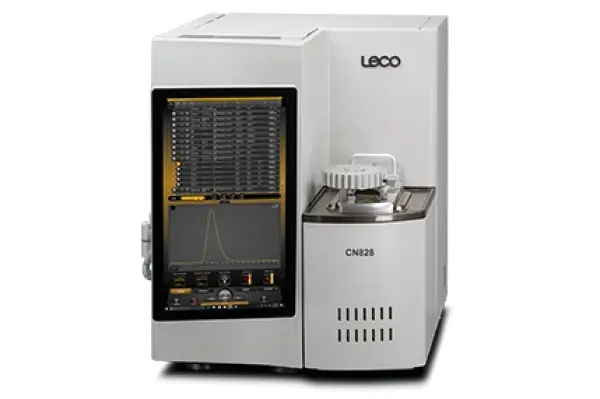828 Series Combustion
Detect Carbon, Hydrogen, Nitrogen, and Protein in Organic Materials
The 828 Series allows you to effortlessly manage a wide range of sample applications by incorporating cutting-edge technology and an on-board, touch-screen software platform. The essential features and performance of earlier LECO macro combustion instrument generations have been preserved, but important improvements in throughput, uptime, and dependability have been made. The S832 add-on is compatible with all 828 Series models and provides independent sulphur determination. The 828’s macro sample mass capability, along with cycle times as quick as 2.8 minutes, makes it a perfect instrument for a wide range of applications while providing unmatched sample analysis throughput.

Features
- Increase laboratory productivity by utilising unrivalled sample throughput.
- On FP/CN models, a 2.8-minute cycle time increases productivity.
- Instrument uptime is improved with longer reagent lives.
- Downtime and time spent on routine maintenance are reduced when common maintenance areas are easily accessible.
- The rugged 30-sample autoloader may be enlarged to hold up to 120 samples, increasing lab efficiency.
- Ergonomic, operator-centered design with touch-screen interface positioned atop the boom.
- With a regent-free design, the furnace’s efficiency and dependability have increased.
Applications
Feeds, Pet Foods, Grains and Cereals, Milled Products, Fermentation Products, Dairy Whey and Cheese Products, Soils, Sediments, Fertilizers, Plant Tissue, Waste Materials, Resins and Polymers, Coal and Coke, Biomass Materials, and Petroleum Products and Additives are just a few of the applications for the 828 series.
Theory of Operation
The 828 Series analyses nitrogen/protein, carbon/nitrogen, and carbon/hydrogen/nitrogen in a wide range of organic matrices, including food and feed, soils, and fuels. The system uses a combustion approach with a vertical quartz furnace to handle a wide range of sample matrices with short cycle times and long reagent lives, resulting in unrivalled throughput and instrument uptime.
To begin an analysis, the sample is weighed into a tin capsule or encapsulated within tin foil and placed into the loader. A fully-automated analysis sequence transfers the sample to a sealed purge chamber, where atmospheric gas is removed. The purged sample is transferred automatically into a reticulated ceramic crucible within the furnace. To ensure complete and rapid combustion (oxidation) of the sample, the furnace environment is composed of pure oxygen with a secondary oxygen flow being directed to the sample within a reticulated crucible via a quartz lance.
The combustion gases are swept from the furnace through a thermoelectric cooler to remove moisture and collected in a ballast volume in the FP and CN828 models. Combustion gases from the furnace are swept through an afterburner containing reagent to scrub sulphur compounds from the gas stream before being collected in the ballast volume in the CHN828 model. Before a representative aliquot of the gas is withdrawn and put into a running stream of inert gas for examination, the gases equilibrate and mix within the ballast.
The aliquot gas is sent to a non-dispersive infrared (NDIR) cell for carbon (as carbon dioxide) detection and a thermal conductivity cell (TC) for nitrogen detection, depending on the analyzer model (N2). The ballast gas is also routed to an H2O NDIR cell in the CHN828 model for hydrogen determination. Because TC cells are chemically non-specific, as opposed to NDIR cells, a sequence of reagents and scrubbers are used to assure quantitative N2 detection without chemical interference. Nitrogen oxide species (NOx) are converted to N2 and surplus oxygen is removed using a heated reduction tube packed with copper. LECOSORB removes carbon dioxide (CO2), while Anhydrone removes water vapour (H2O).
By interleaving the sample loading sequence with quantification of the aliquot gases from the preceding sample, careful sequencing of the analysis ensures maximum sample throughput.
The 828 Series analyzer has a lot of diagnostic sensing capabilities. Multiple Pressure Transducers (PT) have been provided to allow for leak checking of particular flow channel segments.
